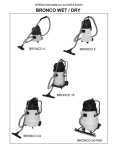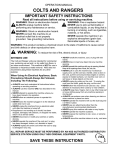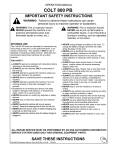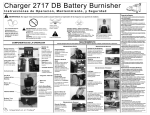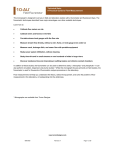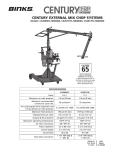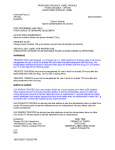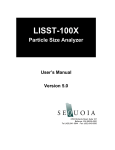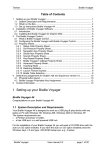Download PONY 20 SCA CARPET EXTRACTOR
Transcript
OPERATION MANUAL PONY 20 SCA CARPET EXTRACTOR IMPORTANT SAFETY INSTRUCTIONS Read all instructions before using or servicing machine. WARNING: Shock or electrocution hazard. ALWAYS unplug machine before performing any maintenance or service. WARNING: Shock or electrocution hazard. NEVER connect this machine to an electrical outlet that is not properly grounded. See grounding instructions. WARNING: Fire or explosion hazard. NEVER use to pick up flammable or combustible liquids, or any thing that is burning or smoking, such as cigarettes, matches or hot ashes. NEVER operate this machine in an explosive atmosphere (grain dust, flammable liquids or fumes, etc. WARNING: To reduce the risk of fire, electric shock, or injury: INTENDED USE • NEVER handle the machine, cord, or plug with wet hands. The Pony 20 SCA Carpet Extractor is intended for commercial use, cleaning and extracting floors, furniture, • NEVER drop or insert any object into any machine opening. draperies and automobile interiors in an indoor • NEVER operate this machine with any air opening environment. This machine is intended for Wet pickup blocked. Keep all air openings free of dust, lint, hair, only. NSS does not recommend using these machines etc. for any other purpose. • NEVER pull or carry the machine by it’s electrical When Using An Electrical Appliance, Basic supply cord, use the cord as a handle, close a door on Precautions Should Always Be Followed, the cord, pull the cord around sharp edges or corners, expose to heated surfaces, run machine over cord, or Including The Following: set heavy or sharp objects on the cord. • ALWAYS read and understand all instructions before • NEVER unplug by pulling on the cord. To unplug the operating or servicing machine. cord from the outlet, grasp the plug, not the cord. • ALWAYS use this machine ONLY as described in this • NEVER allow this machine to be used as a toy. Close manual. attention is necessary when used by or near children. • NEVER attempt to operate this machine unless you • ALWAYS keep face, fingers, hair or any other body have been trained in its operation. part or loose clothing away from any machine opening • NEVER allow an untrained person to operate this or moving part. machine. • ALWAYS use extreme care when cleaning on stairs • NEVER leave the machine plugged in to the electrical or when machine is placed on stairs. outlet when not in use. • NEVER operate the machine without the filters in • NEVER unplug the machine from an electrical outlet place. until after the machine is turned off. • ALWAYS place this machine on a firm flat surface. • If appliance is not working as it should, has been • NEVER use any attachments other than the dropped, damaged, left outdoors, or dropped into manufacturers recommended attachments. water, return it to a service center. • NEVER spray this machine with water or any liquids. • NEVER operate this machine in standing water. • NEVER operate this machine outdoors. • NEVER disconnect or modify any switches or safety • NEVER expose the machine to rain, snow, or extreme devices. temperatures. • NEVER operate this machine if the cord and / or plug • ALWAYS store this machine indoors in a dry, cool has been damaged, broken, cut, abraded or taped. area. • ALWAYS replace the entire cord when the cord or • NEVER use this machine to dry vacuum a floor plug is damaged in any way. or upholstery. ALL REPAIR SERVICE MUST BE PERFORMED BY AN NSS AUTHORIZED DISTRIBUTOR / SERVICE STATION USING ONLY NSS ORIGINAL EQUIPMENT PARTS. SAVE THESE INSTRUCTIONS MANUEL D'UTILISATION PONY 20 SCA CARPET EXTRACTOR IMPORTANTES INSTRUCTIONS DE SÉCURITÉ Lisez toutes les instructions avant d’utiliser ou de réparer et faire l’entretien de l’appareil. AVERTISSEMENT : Danger de choc AVERTISSEMENT : Danger d'incendie ou ou d'électrocution. d'explosion. TOUJOURS débrancher l'appareil NE JAMAIS utiliser pour ramasser des liquides avant tout entretien ou réparation. inflammables ou combustibles ou toute autre AVERTISSEMENT : Danger de choc chose qui brûle ou fume, comme des ou d'électrocution. cigarettes, des allumettes ou des cendres NE JAMAIS brancher cet appareil à chaudes. une prise électrique qui n'est pas mise NE JAMAIS faire fonctionner cet appareil dans à la terre correctement. Voir les un milieu explosif (poussière céréalière, instructions de mise à la terre. liquides ou fumées inflammables, etc.) Pour réduire le risque d’incendies, de choc électrique ou de blessures. • NE JAMAIS laisser tomber ou insérer un objet dans UTILISATION PRÉVUE AVERTISSEMENT: toute ouverture de l'appareil. L'extracteur de tapis Stallion 8 SC est un appareil à • NE JAMAIS faire fonctionner cet appareil lorsqu'une utilisation commerciale, pour nettoyer et extraire les ouverture d'air est bloquée. Garder toutes les ouvertures planchers, les meubles, les tentures et l'intérieur des d'air libres de poussières, peluche, cheveux, etc. voitures dans un milieu intérieur. Cet appareil est réservé • NE JAMAIS tirer ou porter l'appareil par son cordon au ramassage humide. NSS ne recommande pas électrique, utiliser le cordon comme poignée, fermer d'utiliser ces appareils à d'autres fins. une porte sur le cordon, tirer le cordon autour de bords En utilisant un appareil électrique, on doit ou coins tranchants, exposer à des surfaces chauffées, suivre les précautions de bas, y compris ce faire passer l'appareil sur le cordon, ou déposer des qui suit: objets lourds ou tranchants sur le cordon. • NE JAMAIS débrancher en tirant le cordon. Pour • TOUJOURS lire et comprendre toutes les instructions débrancher le cordon de la prise, agripper la fiche non avant d'utiliser ou de réparer l'appareil. pas le cordon. • TOUJOURS utiliser l'appareil SEULEMENT selon la • NE JAMAIS laisser cet appareil servir de jouet. description dans ce manuel. Attention tout particulièrement lorsque l'appareil est • NE JAMAIS essayer de faire fonctionner cet appareil à utilisé par ou près d'enfants. moins d'être formé pour son utilisation. • TOUJOURS garder le visage, les doigts, les cheveux • NE JAMAIS permettre à une personne non formée de ou toute autre partie du corps ou vêtements amples faire fonctionner cet appareil. loin de toute ouverture de l'appareil ou pièce mobile. • NE JAMAIS laisser l'appareil branché dans la prise de • TOUJOURS utiliser l'appareil prudemment en nettoyant courant lorsqu'il n'est pas utilisé. les escaliers ou lorsque l'appareil lui-même est sur • NE JAMAIS débrancher l'appareil de la prise de l'escalier. courant avant qu'il ne soit éteint. • NE JAMAIS faire fonctionner l'appareil sans que les • SI l’appareil ne fonctionne pas correctement, a été filtres ne soient en place. échappé, endommagé, laissé à l’extérieur ou échappé • TOUJOURS placer cet appareil sur une surface ferme dans l’eau, retournez-le à un centre de service. et à plat. • NE JAMAIS faire fonctionner cet appareil dans de l'eau NE JAMAIS utiliser d'accessoires autres que ceux • stagnante. recommandés par le fabricant. • NE JAMAIS débrancher ou modifier les interrupteurs • NE JAMAIS pulvériser cet appareil d'eau ou d'autres ou les dispositifs de sécurité. liquides. • NE JAMAIS faire fonctionner cet appareil si le cordon • NE JAMAIS faire fonctionner l'appareil à l'extérieur. et / ou la fiche est endommagé(e), brisé(e), coupé(e), • NE JAMAIS exposer l'appareil à la pluie, à la neige ou usé(e) ou scellé(e) avec un ruban adhésif. à des températures extrêmes. • TOUJOURS remplacer tout le cordon lorsque ce • dernier ou la fiche est endommagé(e) de quelque façon TOUJOURS ranger cet appareil à l'intérieur dans un endroit sec et frais. que ce soit. DO NOT use this machine to dry vacuum a floor • • NE JAMAIS manipuler l'appareil, le cordon ou la fiche or upholstery. avec les mains mouillées. TOUTES LES RÉPARATIONS DOIVENT ÊTRE EFFECTUÉES PAR UN DISTRIBUTEUR / STATION SERVICE AUTORISÉ(E) NSS UTILISANT SEULEMENT DES PIÈCES ORIGINALES NSS. CONSERVER CES INSTRUCTIONS IMPORTANT SAFETY INSTRUCTIONS GROUNDING OF ELECTRICAL EQUIPMENT WARNING: Improper connection of the equipment–grounding conductor can result in a risk of electric shock. Check with a qualified electrician or service person if you are in doubt as to whether the outlet is properly grounded. Do not modify the plug provided with the machine – if it will not fit the outlet; have a proper outlet installed by a qualified electrician. Always use a properly grounded 3-wire extension cord, which has male and female plugs. If 25 foot extension cords are used, the electrical carrying capacity should be no less than 14-3 ST., 50-foot extension cords no less than 12-3 ST. GROUNDING INSTRUCTIONS This machine shall be grounded while in use to protect the operator from electric shock. The machine is provided with a three-conductor cord and a three-contact grounding type attachment plug. The plug must be plugged into an appropriate outlet that is properly installed and grounded in accordance with all local codes and ordinances. The green conductor in the cord is the ground wire. Never connect this wire to other than the grounding pin of the attachment plug. Check nameplate on the machine to be sure voltage and cycle stated is the same as the electrical outlet. Do not attempt to plug a 120-volt machine into a 240-volt outlet or a 240-volt machine into a 120-volt outlet. If the machine is provided with an attachment plug as shown in Figure A. below, it is intended for use on a nominal 120-volt circuit. If a properly grounded receptacle as shown in Figure A. is not available, an adapter may be installed as shown in Figure B. if the outlet box that houses the receptacle is grounded. Be sure to fasten the grounding tab (the green colored rigid ear, lug or the like extending from the adapter) with a metal faceplate screw. If the machine is provided with an attachment plug as shown in Figure C., it is intended for use on a nominal 240-volt circuit. No adapter is available for this plug. NOTE: In Canada, the use of a temporary adaptor is not permitted by Canadian electrical code. ALL REPAIR SERVICE MUST BE PERFORMED BY AN NSS AUTHORIZED DISTRIBUTOR / SERVICE STATION USING ONLY NSS ORIGINAL EQUIPMENT SAVE THESE INSTRUCTIONS IMPORTANTES INSTRUCTIONS DE SÉCURITÉ MISE À LA TERRE DE L'ÉQUIPEMENT ÉLECTRIQUE AVERTISSEMENT: Toute mauvaise connexion de l'appareilconducteur de mise à la terre peut mener à un risque de choc électrique. Vérifier auprès d'un électricien ou d'un réparateur qualifié si vous avez des doutes quant à la mise à la terre appropriée de la prise. Ne pas modifier la fiche fournie avec l'appareil – si elle n'entre pas dans la prise, faire installer une prise appropriée par un électricien qualifié. Toujours utiliser une rallonge à 3 fils mise à la terre et à prises mâle et femelle. Si vous utilisez une rallonge de 25 pieds, la capacité électrique de transport doit être d'au moins 14-3 ST., les rallonges de 50 pieds d'au moins 12-3 ST. INSTRUCTIONS DE MISE À LA TERRE Cet appareil doit être mis à la terre lorsqu'il est en marche pour protéger l'opérateur de tout choc électrique. L'appareil est fourni avec un cordon à 3 conducteurs et une fiche de branchement masse à trois contacts. La fiche doit être branchée dans une prise appropriée, installée et mise à la terre correctement selon tous les codes et ordonnances locaux. Le conducteur vert du cordon est le fil de masse. Ne jamais brancher ce fil à autre chose que la broche de masse de la fiche de branchement. Vérifier la plaque signalétique de l'appareil pour être certain que la tension et le cycle indiqués sont les mêmes que la prise électrique. Ne pas essayer de brancher un appareil de 120 volts à une prise de 240 volts ou un appareil de 240 volts à une prise de 120 volts. Si l'appareil est fourni avec une fiche de branchement tel qu'indiqué dans la figure A. plus bas, il doit donc être utilisé avec un circuit nominal de 120 volts. S'il n'y a pas de prise mise à la terre telle qu'indiqué dans la figure A. disponible, on peut installer un adaptateur tel qu'indiqué dans la figure B. si la boîte à prises est mise à la terre. S'assurer d'attacher la patte de mise à la terre (boucle, cosse rigide de couleur verte ou quelque chose de semblable sortant de l'adaptateur) avec une vis de plaque signalétique de métal. Si l'appareil est fourni avec une fiche de branchement tel qu'indiqué dans la figure C., il doit donc être utilisé avec un circuit nominal de 240 volts. Il n'y a aucun adaptateur disponible pour cette fiche. REMARQUE : Au Canada, l'utilisation d'un adaptateur temporaire est interdite par le code d'électricité canadien. TOUTES LES RÉPARATIONS DOIVENT ÊTRE EFFECTUÉES PAR UN DISTRIBUTEUR / STATION SERVICE AUTORISÉ(E) NSS UTILISANT SEULEMENT DES PIÈCES ORIGINALES NSS. CONSERVER CES INSTRUCTIONS NOISE AND VIBRATION NOISE Sound pressure level at Operator position VIBRATION Weighted RMS acceleration value (ISO 5349) 75dB(A) .195 m/s2 MACHINE INSPECTION • Now that the machine is unpacked remember to recycle all packing materials. • Inspect the machine for damage or missing components. If damage is found, contact the local freight company to file a freight claim. MACHINE COMPONENTS Solution Tank The solution tank is the lower part of the machine body. It has a capacity of 20 Gallons (75 liters). Recovery Tank The recovery tank is the upper part of the machine body. It has a capacity of 20 gallons (75 liters). Control Panel The operator control panel is located at the upper rear area of the machine. Operator controls are positioned for ease of use, and include icons for simplified user training. This panel has components that control various machine functions: • Located in the upper right corner, is the master switch, this switch turns the unit on and off, it must be turned on before any other switch will work. • Just below the master switch is the speed control knob; this knob controls the forward movement of this machine. Note: This machine does not have a reverse option. • In the middle of the control panel are three switches. The top switch activates the solution spray, the middle switch activates the brushes, and the bottom switch activates the vacuum. • At the bottom of the control panel are two circuit breakers, the one on the left is for the brush motor, and the one on the right is for the drive motor. • If the brush becomes over loaded by: hair, deep pile carpet, strings, or an obstruction, the motor will draw too much current and the circuit breaker will trip. Vacuum Motor The vacuum motor is a three stage, 1 3/4 HP bypass style, with peripheral discharge. It is enclosed in a housing to aid in noise reduction and improve airflow cooling. Gear Drive Motor A gear-reduction motor propels this machine via a chain and sprocket system. Variable speed is adjusted at the operator control panel. Brush Motor A 1/4 HP permanent magnet motor, via a cog belt and pulley system, drives the brush. Solution Pump This pump is a 100-PSI continuous type, three-piston bypass valve style. Brush Head Assembly This machine has a floating brush head assembly that adapts to the different carpet pile heights. The brush head is offset to the left side of the machine to clean against the wall. • The brush shoe and brush head "float" and will swing out from the wall if they get too close to the wall. This avoids gouging the wallboards or the wall. • The brush is a 22” wide nylon bristle, four-row chevron design. • The brush head assembly includes the Solution Spray System - Spray Bar and five Spray Tips. Solution is applied to the carpet through these tips. Vacuum Shoe The vacuum shoe is a 27” wide, weighted aluminum casting. Mounted with a bearing and a nylon bushing it is able to swing and swivel on a center arm. As the machine moves forward the vacuum shoe pulls the liquid out of the carpet. Body / Casters / Chassis / Wheels Two - 8” diameter, grooved non-marking rubber tread, clutch-type bearing wheels, allows this machine to be pushed forward without the use of the drive motor. These wheels will rotate freely when turned toward the front of the machine (clockwise on the right - counterclockwise on the left). Two - 4” diameter swivel casters are mounted on the steel frame at the rear of the machine, they provide maneuverability and stable control of this machine. Float and Screen Assembly Vacuum air is removed from the recovery tank via the float and screen assembly, as the water level rises, so does the float. When the float reaches the top, it will shut off the airflow of the vacuum. • It does not shut off the vacuum motor. • Stop the machine and empty the Recovery tank. Accessory Spray Wand Located at the right, rear side of the machine, this spray wand may be used to pre-spray a wide area of carpet before extraction. It may also be used to apply additional cleaning solution to trouble spots while extracting. Accessory quick connect option This connection is located at the lower left side of the machine, (The accessory spray wand hose is connected here.) this connection can be used to attach any of the accessory kits. Solution Gage Hose • The amount of fluid in the tank is visible via the clear hose at the back left of the machine. As you clean, keep an eye on the liquid level, refill as needed. This hose can be used to drain the tank by pulling down on the hose from the top. PREPARING THE MACHINE Preparing the Solution and Recovery tanks: • Never use water over 140°F (60°C). • Excessively hot water will damage components such as the pump, valves, and seals. Observe the carpet manufacturer’s cleaning instructions. • Make sure the black drain hose from the Recovery tank is securely closed to keep fluids from draining out. To close; twist the drain hose plug into the end of the hose with a clockwise rotation. • Put 1 to 2 gallons (4 to 8 liters) of water in the solution tank to help dilute the chemicals and prevent excess sudsing. Dilute the cleaning chemicals according to the manufacturer’s instructions. • Fill the tank by pouring the water and cleaning chemicals through the mesh filter that covers the opening at the front of the solution tank. • Always use a defoamer in the Recovery tank to protect the vacuum motor of this machine. • Every time the solution tank is filled, add 4 to 6 ounces (125 to 188 milliliters) of defoamer to the Recovery tank. • Make sure the clear dome and gasket fits securely on the recovery tank for an airtight seal. The vacuum motor will pull the dome down (creating a suction) during use. Connect the Power Cord This machine is equipped with a twist lock power cord. • Align the three electrical contacts, push the contacts together and turn one of the plugs 1/8 of a turn to lock the two plugs in place. This will prevent the machine from disconnecting during use. NOTE: Some models may have a direct-wired power cord. Attach the Vac Shoe The vac shoe lift cable is already attached to the lift mechanism for the vac shoe. • To attach the vac shoe, simply slide the tool onto the threaded rod and secure with a washer and nut, then slide the vac hose over the stock of the vac shoe. The vac shoe is now ready for operation. • The vac shoe is easily removed for cleaning or machine transportation by removing the nut. Checking the Spray Bar and Jets Before attempting to operate the machine, it may be necessary to check the spray jets and see if they are clean. If the machine has been used previously, cleaning solution may have settled into the spray jets and dried, clogging them. • In order to check the spray jets, you must remove the spray jet bar from the brush housing. • Disconnect the quick connect on the end of the solution hose from the quick connect on the spray jet bar. Simply pull out the spray jet bar from the brush head and reconnect the solution hose to the quick disconnect on the spray jet bar. • Aim the spray jet bar at the carpet. • Turn “ON” the master switch, then the spray pump. • Turn the speed control to its slowest speed so the machine does not propel itself. • Squeeze the deadman switch below the control handle of the machine. Solution will spray through the jets and onto the carpet; this will allow you to see if all the spray jets are clean. • If one of the jets is not spraying, push in on the spray jet, then with just a quarter of a turn in either direction, turn the jet and remove it from the spray jet bar. • Rinse the spray jets with warm water, or make a solution of 25% vinegar and warm water, and soak the jets for a few minutes to clean them. If an insoluble material is plugging the jets, use a wooden toothpick to clean the clogged jet. Do not use a knife or other sharp object - sharp objects will distort the spray pattern. • Reattach the jet to the spray bar by reinserting the tip and turning it clockwise. Priming the Solution Pump During normal use the solution tank may run dry. This will allow air to enter the pump, and solution lines, causing an air lock in the solution lines. The air lock prevents the pump from working properly; you must prime the pump. • The solution tank should have liquid in it, and the in-line filter screen should be clean and free of debris. • Turn the master switch and spray switch “ON”. • Stand at the side of the machine and depress the pin in the center of the accessory quick disconnect. The pump will push solution, and air, out of the quick connect. To purge the solution lines, run the pump for 30 seconds, or until the solution flows smoothly. • Recheck the spray output at the spray jet bar assembly. MACHINE OPERATION This machine is very maneuverable and is designed to clean as you move forwards across the carpet. Drive the machine to the cleaning site by: Turning the master switch to "ON", squeeze the deadman lever, and turn the speed control to get the desired speed. Normal Cleaning • Always vacuum the carpet with a vacuum cleaner before extraction. • We recommend you wear clean tennis shoes or non-slip shoes when working with a carpet extractor. Street shoes or rubber cushion soled shoes when wet will release absorbed dirt or grease onto the wet carpet and cause re-soiling. • You may need to pre-treat spots and heavy traffic lanes before extraction. Refer to the “Common Stains and Cleaning Treatments” chart for examples of types of stains and the solution used to treat the stain. • Test the cleaner on a small; inconspicuous area to make sure it will not damage the carpet fibers. • Apply appropriate spotter, following directions on the container. • You may apply the pre-treat chemicals in a number of ways: • Use a hand held spray bottle. There is room for two bottles of spotting liquid on the shelf at the back of the machine. Let the spray sit on the stain for about five minutes; soak up excess liquids with a towel. • Use the accessory spray wand by squeezing the trigger on the spray wand; this will draw cleaning solution from the machine’s solution tank. • Do not attempt to pre-spray areas that you will not over-scrub with the machine within a ten-minute time span. To operate the machine: • Turn the master switch "ON". • Check the brush and pump for proper operation, turn both switches to “ON”. • Lower the brush head by moving the left lever to the left, and releasing it, the brush head will move into position on the carpet. • Lower the vacuum shoe to the carpet with the right lift lever, by moving the lever to the right and releasing it. Note: You must lift the vacuum shoe when moving this machine in reverse. • Squeeze the deadman lever under the control handle in order to propel forward and activate the brush. • Turn the speed control to propel the machine at the required speed. Note: You may also “lockdown” the vacuum shoe to the carpet for better recovery. From the floating position push down on the right lever and lock it under the notch. • Plan your work based upon available electrical outlets. • Using the bumper wheel, located on the right side of the machine, align the machine as close to the wall as possible. • Start at the electrical outlet to which your machine is plugged into, clean along the wallboards, away from your outlet. This helps to avoid running over the cord during operation. • It is possible to transverse 75 feet (the length of your cord) away from the wall outlet to which your machine is plugged in. • Usually, areas closest to the walls are the least soiled; the speed control can be set at its mid point, or turned up to a higher speed. • The brush shoe and brush head will swing out from the wall if they get too close to the wall. This avoids gouging the wallboards or the wall. • Cross to the other side of the hall or room and work your way back along the opposite wall for as far as the length of the cord will allow. • It is best to allow for a two-inch overlap on each pass to be sure you have covered all of the carpet. • If time allows after you have completed extracting, turn the spray switch “OFF”, then with both the vac switch and brush switches ”ON”, make high-speed passes over the carpet. The high-speed vacuuming of the extracted carpet will remove excess moisture, speed up the drying time, and set the pile, leaving a better appearance. • Empty the recovery tank as needed during operation. • Use an air mover dryer to speed up the drying time. Do not apply water more than twice in one area to prevent excess wetting. • Over-wetting can damage the carpet and the underlying floor. SPECIAL CLEANING This machine may be used to perform special cleaning jobs other than “normal” scrubbing. Double Scrubbing This procedure provides deeper cleaning on heavily soiled floors. • Double scrub by making a second pass over the carpet with only the brush turned on. Then, make a third pass with the solution pump, vacuum and brush on to remove the most dirt. Make an additional vacuum pass to dry the carpet as much as possible. • The slower the cleaning pass, the more dwell time, increasing the amount of dirt that is removed from the carpet. OPTION - ACCESSORY CLEANING Cleaning upholstery, stairs or confined areas: • Prepare the solution / recovery tanks as you would for normal carpet cleaning. • Select the correct tool for the job to be performed. • Remove the quick connect that is attached to the accessory spray wand hose, by pushing the outer collar back and pulling on the hose fitting. • Connect the solution hose, which is part of any of the accessory kits, push the outer collar back and insert the hose fitting fully. Release the collar to secure the hose in place. • Solution from the solution tank is supplied to this outlet when the solution pump is “ON”, but will only dispense solution when the trigger of the upholstery, stair tool or jet wand is squeezed in the “ON” position. • Remove vac hose from vac shoe and attach accessory vac hose cuff to machine vac hose. Do not apply water more than twice in one area to prevent excess wetting. • Over-wetting can damage upholstery and / or fabric. MACHINE MAINTENANCE Routine maintenance is critical to ensure proper machine operation and cleaning performance. Perform all maintenance procedures as follows. Always turn OFF all machine switches before performing any maintenance. All the switches, and the brush and vacuum shoe handle linkages can be accessed by removing the screws securing the switch control panel to the body. All motors and pumps located inside the body can be accessed by the following procedures: • Locate the mounting studs and nuts for the swivel casters. Remove only the rear / outer nuts. This will disconnect the rear of the main body from the chassis. Disconnect the tool rod, solution hose and accessory hose. • Lift the rear of the machine body to tilt forward for access (the prop rod that holds up the machine, is under the solution tank). DAILY MAINTENANCE At the end of the day empty all liquids from both the solution and recovery tanks. Rinse both tanks with clean water to remove debris and prevent chemical residue build up, to prevent odors from building up; turn the clear dome sideways; this provides an opening, to allow the tanks to air dry. • The solution tank can be emptied by, vacuuming the residue solution into the recovery tank. • Remove the vac hose, which is connected to the vac shoe. Pull the clear solution tank hose down, and insert it into the vac hose. Turn "ON" the vacuum motor and suction all of the liquid into the recovery tank. • When the solution tank is empty turn the switches "OFF". • To empty the recovery tank remove the hose from the bracket, clamp the hose with your hand and lower or aim the hose in the direction that you want the solution to flow. • Turn the stopper counterclockwise and remove it, unclamp your hand and allow the solution to drain. Dispose of the liquids according to your local EPA regulations. • There is a metal screen cartridge on top of the vacuum tube under the clear dome. Remove any residue from the screen to ensure proper operation. • Store the machine in a dry area. • Store with brush assembly up. • Check the drain hose for damage. • Remove the spray tips (1/4 turn) from the spray bar and put them in a glass or plastic container with a solution of 25% vinegar and water overnight to remove any chemical residue. • Unplug the machine and inspect the brush assembly (paying special attention to the ends of the rollers) for buildup of carpet fibers, hair or other materials. • Remove all debris from the brush. Failure to remove this material could: overload the circuit breaker, jam and break the belt, obstruct and damage the bearings, or burn out the brush drive motor. Weekly Maintenance (25 Hours) • Verify all daily and weekly maintenance has been performed. • Flush clean solution tank and hoses with a mixture of 8 ounces (250 milliliters) white vinegar to onegallon (4 liter) warm water. • Pour it into the solution tank, turn the machine “ON” and operate it to completely clean the tank, and the spray jets, (running for 30 seconds should be sufficient). This will remove any chemical residue. Failure to flush the solution system will result in poor spray patterns and corroded jet spray tips. • Remove and clean the fine mesh filter in the bottom of the solution tank. This filter is mounted externally under the right / rear side of the solution tank (body). To remove the screen for cleaning you must first disconnect the hex nut of the solution hose, and then turn the lower half of the filter 1/8 of a turn counterclockwise. • Remove the lower half of the filter, and mesh screen to clean. CAUTION If there is any clean solution in the tank it will drain out at this time. Reassemble and check for leaks. • The intake of the vacuum shoe and the vac shoe must be kept clean and free of any debris or obstructions such as carpet fibers, to ensure proper flow of extracted liquids. The rear cover plate may be removed to allow for a detailed interior cleaning. • Repair or replace any worn or damaged components as needed. Mandatory Periodic Maintenance It is mandatory that the following maintenance procedure be performed at the described interval. Failure to perform this procedure may result in poor machine performance, machine component damage and failure. This procedure should be performed by an NSS authorized distributor or service center. Repairs performed by an unauthorized company will void the machine warranty. If you require assistance finding an authorized service center, please contact NSS Enterprises, Inc. After every 750 hours of operation. • Inspect the vacuum motor carbon brushes for wear. Replace the vacuum motor carbon brushes when they are 7/16in. (11mm) in length. • Check the belt to the brush for wear and tightness. • The swivel and wheel bearings must be lubricated on a regular basis to ensure trouble-free operation. Use non-water soluble grease for lubrication. • The drive chain tension should be checked every 90 days and adjusted if necessary. To adjust the drive chain tension, you must first loosen the four hex bolts in the chassis slots under the propulsion motor. Slide the motor forward to decrease, or backward to increase the chain tension. • The drive chain should be lubricated every 90 days with a penetrating moisture resistant lubricant, using a spray can with attachable straw to apply. DO NOT lubricate the chain when the machine is on a carpeted surface. • Wipe off any excess lubricant before operating the machine. BRUSH MOTOR / BRUSH ASSEMBLY / BELT The brush motor, brush assembly and belt are serviced by removing both parts of the plastic twopiece brush housing cover. • The brush drive belt tension is adjusted by first loosening the brush motor mounting hex nuts. Slide the motor toward the brush to decrease the tension, and away from the brush to increase the tension. When the motor is in the proper position, the drive belt should have 1/4” to 3/8” deflection midway between the motor and brush pulley. • To replace the brush drive belt, you must remove the brush shaft mounting screw at the pulley end and loosen the screw at the opposite end. Install the new belt on the pulleys, replace and tighten the brush shaft mounting screws, and adjust the belt tension. • Bristles will wear to the point where there is not enough agitation of the carpet. The nylon roller wheel can be raised to lower the brush deeper into the carpet. Remove the roller axle that attaches the roller wheel from its holding bracket, and reinstall the axle into the upper holes in the bracket. WARNING Do not use the upper roller axle position with a new or nearly new brush. This will force the brush to an exaggerated down position, overload the circuit breaker, and damage the brush drive motor. • Adjustment or replacement of the brush assembly requires removal of both brush-shaft mounting screws; this allows the brush assembly to be removed from the housing. When installing the new brush assembly, do not over tighten the shaft screws. This will prevent binding of the brush assembly. • Replacement of the brush drive motor (no motor component parts available) requires the removal of the mounting hex nuts and wires to the rectifier and ground wire. Adjust the drive belt tension after replacing the motor. COMMON STAINS AND CLEANING TREATMENTS TREATMENT METHODS • Remove excess material; if the stain is liquid blot excess liquids with a dry cloth or paper towel, if the material is a solid remove it by scraping it with a dull edge (butter knife). • Clean the remaining stain as directed by the chart below. Always follow the directions on the container. Apply the cleaning material directly to the stain (avoid over wetting the carpet or upholstery). Remove the loosened stain material with a white absorbent cloth, tissue, or paper towel. • When the carpet is dry, gently brush the carpet pile to restore its appearance. • Treat unknown stains with a volatile solvent first and follow with other agents as required. If you are uncertain of the effect of the cleaning agent on the carpet fiber or dye, test on an inconspicuous area first. STAIN TYPE TREATMENT MATERIAL Asphalt Volatile solvent / detergent Beer Liquid detergent / White vinegar Berry Stain Liquid detergent / Ammonia 3 - 6%, Water Bleach Liquid detergent / Water Blood (dried) Warm detergent / Ammonia 3 - 6%, Water Blood (wet) Liquid detergent / Water Butter Volatile solvent Catsup or Mustard Liquid detergent Chewing Gum Volatile solvent Chocolate Liquid detergent / Ammonia water Coffee Detergent / White vinegar / Volatile solvent Cola Drink Liquid detergent Crème de Menthe (green) Liquid detergent Egg (raw) Liquid detergent Food Dye Liquid detergent / Water Furniture Dye Polish Paint / Oil / Grease remover / Detergent Gravy Liquid detergent Lipstick Paint / Oil / Grease remover, Mascara Paint remover / Volatile solvent / Detergent / Water Milk Liquid detergent Orange Drink Liquid detergent / Water Shoe Polish Heated iron into clean towel / Volatile solvent Tea Liquid detergent Tomato Juice Liquid detergent Urine Liquid detergent / Water Vomit Warm detergent / Water / White vinegar Wine Liquid detergent / Ammonia 3-6% / Water / Vinegar TROUBLESHOOTING Symptom Cause Solution No Solution From Spray Tips. Spray nozzle tips plugged. Disassemble and clean. Solution tank empty. Refill tank. Pump failed. Repair or replace as required. Defective pump seal. Replace pump. Incorrect spray nozzles. Install correct spray nozzles. Spray nozzle tips plugged. Clean or replace. Nozzle gasket obstruction. Replace gasket. Incorrect spray nozzles. Install correct spray nozzles. Worn solution pump. Repair or replace as required. Solenoid valve clogged. Bleed air lock from system. Spray nozzle tips plugged. Disassemble and clean. Incorrect spray nozzles. Install correct spray nozzles. Solution tank empty. Refill. Pump failed. Repair or replace as required. Defective pump seal. Replace pump. Kinked solution hose. Straighten hose. Quick connect disconnected. Reconnect fitting onto machine. Uneven Spray Nozzle Pattern. No Solution From Spray Tips On Accessory Wand. Poor Water Pickup. Pump Runs But Has Little Or No Output. Pump Motor Will Not Run. Brush Motor Will Not Operate. Screen and float ball assembly is clogged. Remove and clean screen. Recovery tank lid not sealing. Replace or tighten lid. Internal pump parts worn. Rebuild pump head or replace. Pump air locked. Bleed air lock from system. Solenoid valve will not open. Replace solenoid valve. Solution tank filter plugged. Remove obstacle or replace. Motor shorted out. Replace motor. Faulty pressure switch. Faulty pump switch / wiring. Damaged power cord. Extension cord inadequate. Low voltage. Overloaded circuit breaker. Replace pressure switch. Repair or replace. Replace power cord. Remove extension cord. Test wall outlet. Reset circuit breaker. Unplug other electrical items on same circuit. NSS® Enterprises, Inc. 3115 Frenchmens Road, Toledo, Ohio 43607 PHONE (419) 531-2121 FAX (419) 531-3761 NSS ® Enterprises, Inc. European Distribution Centre Unit II, Pinfold Trading Estate * 55 Nottingham Road STAPLEFORD, NOTTINGHAM NG9 8AD ENGLAND U.K. PHONE: (44) 0115 939 1568 * FAX: (44) 0115 949 0615 Pony 20 SCA Operation Manual Orig. 02-06 9094903












